Related Research Articles
The 1300s was a decade of the Julian Calendar that began on 1 January 1300 and ended on 31 December 1309.

Year 1304 (MCCCIV) was a leap year starting on Wednesday of the Julian calendar.
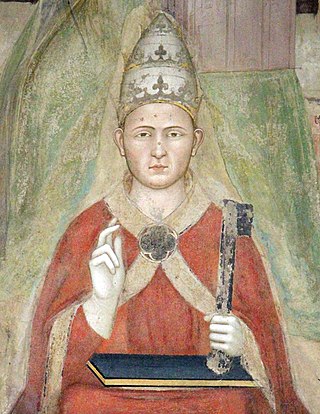
Year 1305 (MCCCV) was a common year starting on Friday of the Julian calendar.

Year 1315 (MCCCXV) was a common year starting on Wednesday of the Julian calendar.

Year 1318 (MCCCXVIII) was a common year starting on Sunday of the Julian calendar.

Philip IV, called Philip the Fair, was King of France from 1285 to 1314. By virtue of his marriage with Joan I of Navarre, he was also King of Navarre and Count of Champagne as Philip I from 1284 to 1305. Although Philip was known to be handsome, hence the epithet le Bel, his rigid, autocratic, imposing, and inflexible personality gained him other nicknames, such as the Iron King. His fierce opponent Bernard Saisset, bishop of Pamiers, said of him: "He is neither man nor beast. He is a statue."

Philip VI, called the Fortunate or the Catholic and of Valois was the first king of France from the House of Valois, reigning from 1328 until his death in 1350. Philip's reign was dominated by the consequences of a succession dispute. When King Charles IV of France died in 1328, his nearest male relative was his sororal nephew, King Edward III of England, but the French nobility preferred Charles's paternal cousin, Philip.
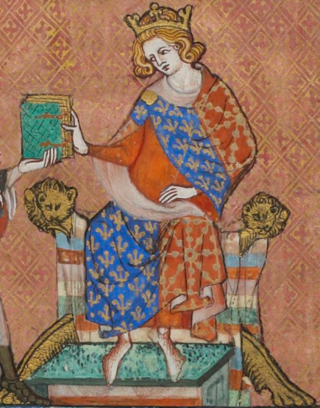
Louis X, known as the Quarrelsome, was King of France from 1314 and King of Navarre as Louis I from 1305 until his death. He emancipated serfs who could buy their freedom and readmitted Jews into the kingdom. His short reign in France was marked by tensions with the nobility, due to fiscal and centralisation reforms initiated during the reign of his father by Grand Chamberlain Enguerrand de Marigny.

Philip III, called the Bold, was King of France from 1270 until his death in 1285. His father, Louis IX, died in Tunis during the Eighth Crusade. Philip, who was accompanying him, returned to France and was anointed king at Reims in 1271.

Philip V, known as the Tall, was King of France and Navarre from 1316 to 1322. Philip engaged in a series of domestic reforms intended to improve the management of the kingdom. These reforms included the creation of an independent Court of Finances, the standardization of weights and measures, and the establishment of a single currency.

Charles IV, called the Fair in France and the Bald in Navarre, was last king of the direct line of the House of Capet, King of France and King of Navarre from 1322 to 1328. Charles was the third son of Philip IV; like his father, he was known as "the fair" or "the handsome".

Joan I was ruling Queen of Navarre and Countess of Champagne from 1274 until 1305. She was also Queen of France by marriage to King Philip IV. She founded the College of Navarre in Paris in 1305.
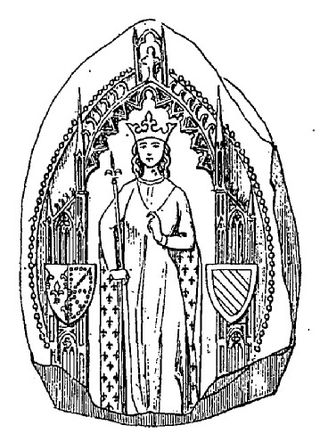
Margaret of Burgundy was Queen of France and Navarre as the first wife of King Louis X; however, she was locked in prison during her whole French queenship.

Marie of Brabant was Queen of France from 1274 until 1285 as the second wife of King Philip III. Born in Leuven, Brabant, she was a daughter of Henry III, Duke of Brabant, and Adelaide of Burgundy.
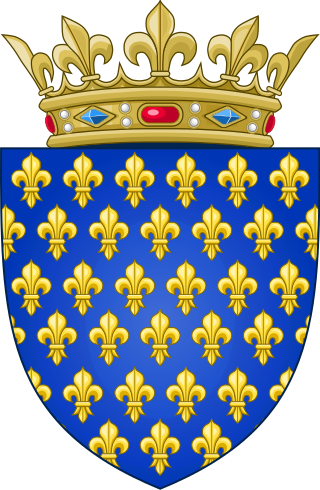
The House of Capet ruled the Kingdom of France from 987 to 1328. It was the most senior line of the Capetian dynasty – itself a derivative dynasty from the Robertians and the Karlings.
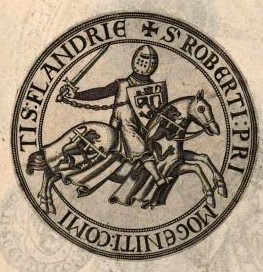
Robert III, also called Robert of Béthune and nicknamed The Lion of Flanders, was the Count of Nevers from 1273 and Count of Flanders from 1305 until his death.
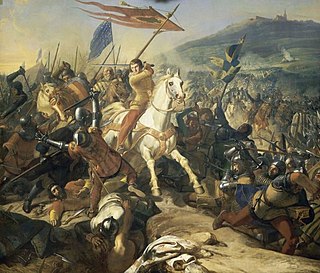
The Battle of Mons-en-Pévèle was fought on 18 August 1304 between the French and the Flemish. The French were led by their king, Philip IV.
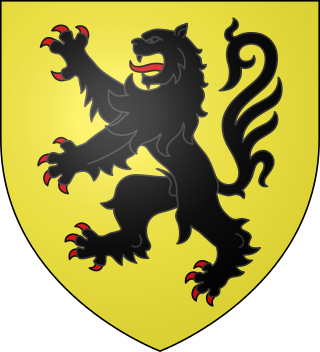
The Treaty of Athis-sur-Orge was a peace treaty signed on 23 June 1305 between King Philip IV of France and Robert III of Flanders. The treaty was signed at Athis-sur-Orge after the Battle of Mons-en-Pévèle and concluded the Franco-Flemish War (1297–1305).
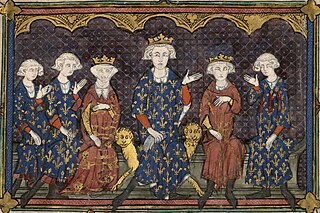
The Tour de Nesle affair was a scandal amongst the French royal family in 1314, during which Margaret, Blanche, and Joan, the daughters-in-law of King Philip IV, were accused of adultery. The accusations were apparently started by Philip's daughter, Isabella. The Tour de Nesle was a tower in Paris where much of the adultery was said to have occurred. The scandal led to imprisonments, torture and executions for the princesses' lovers and the imprisonment of the princesses, with lasting consequences for the final years of the House of Capet.
Events from the year 1302 in France
References
- ↑ "Philip IV Biography, Facts, & Accomplishments". www.britannica.com. Retrieved 26 December 2024.
- ↑ Donzelot, Pierre (1954). French Universities and Their Pursuit of Freedom. Ministère de l'éducation nationale and Columbia University. p. 30. Retrieved 2024-12-27.
- ↑ Sohn, Andreas (2020). "Colleges and the University of Paris, Professors and Students, Religion and Politics: Some Remarks on the History of Europe in the Late Middle Ages (Thirteenth to Fifteenth Centuries)". In Goeing, Anja-Silvia; Parry, Glyn; Feingold, Mordechai (eds.). Early Modern Universities: Networks of Higher Learning. Brill. p. 25.
- ↑ The modern history is by Nathalie Gorochov, Le Collège de Navarre de sa fondation (1305) au début du XVe siècle (1418): Histoire de l'institution, de sa vie intellectuelle et de son recrutement.
- 1 2 "Joan I | Facts & Biography". Encyclopedia Britannica. Archived from the original on July 22, 2018. Retrieved 22 July 2018.
- ↑ Echols, Anne; Williams, Marty, eds. (1992). An annotated index of medieval women. Markus Wiener Publishers. p. 269. ISBN 9780910129275.
- ↑ Strayer, Joseph (1980). The Reign of Philip the Fair. Princeton: Princeton University Press. pp. 9–10. ISBN 978-0-691-10089-0.
- ↑ Street, John C. (1963). "Les Lettres de 1289 et 1305 des ilkhan Arγun et Ölǰeitü à Philippe le Bel by Antoine Mostaert, Francis Woodman Cleaves". Journal of the American Oriental Society (book review). 83 (2): 56–57. doi:10.2307/598384. JSTOR 598384.
- ↑ Gillespie, Alexander (1 December 2016). The Causes of War: Volume II: 1000 CE to 1400 CE. Vol. 2. Bloomsbury Publishing. p. 189. ISBN 978-1849466455.
- ↑ Kittell, Ellen E. (1991). From Ad Hoc to Routine: A Case Study in Medieval Bureaucracy. University of Pennsylvania Press. p. 109.
- ↑ Strickland, Matthew (2010). "The Wars of Philip the Fair and his Successors, 1285–1328". In Rogers, Clifford J. (ed.). The Oxford Encyclopedia of Medieval Warfare and Military Technology. Vol. 2: East-Menf. Oxford University Press.
- ↑ This article incorporates text from a publication now in the public domain : Chisholm, Hugh, ed. (1911). "Audrehem, Arnoul d'". Encyclopædia Britannica . Vol. 2 (11th ed.). Cambridge University Press. p. 899.
- ↑ "Cabassole, Philippe De from the McClintock and Strong Biblical Cyclopedia". McClintock and Strong Biblical Cyclopedia Online. Retrieved 2024-12-27.
- ↑ Eubel I, p. 12. V.-B. Henry, Histoire de l'abbaye de Pontigny (Avallon 1882), p. 143
- ↑ Menache, Sophia (2002). Clement V. Cambridge University Press. p. 17.
- ↑ Waugh, Scott L. (1988). The Lordship of England: Royal Wardships and Marriages in English Society and Politics, 1217-1327. Princeton University Press.
- ↑ Delaville Le Roulx, Joseph (1904). Les Hospitaliers en Terre Sainte et à Chypre (1100-1310). E. Leroux, Paris.